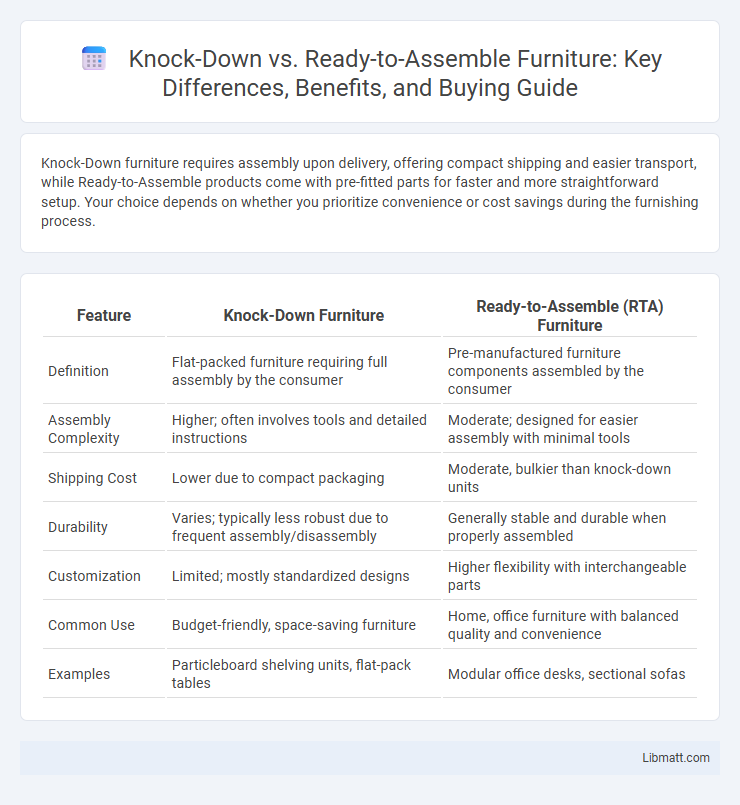Knock-Down furniture requires assembly upon delivery, offering compact shipping and easier transport, while Ready-to-Assemble products come with pre-fitted parts for faster and more straightforward setup. Your choice depends on whether you prioritize convenience or cost savings during the furnishing process.
Table of Comparison
| Feature | Knock-Down Furniture | Ready-to-Assemble (RTA) Furniture |
|---|---|---|
| Definition | Flat-packed furniture requiring full assembly by the consumer | Pre-manufactured furniture components assembled by the consumer |
| Assembly Complexity | Higher; often involves tools and detailed instructions | Moderate; designed for easier assembly with minimal tools |
| Shipping Cost | Lower due to compact packaging | Moderate, bulkier than knock-down units |
| Durability | Varies; typically less robust due to frequent assembly/disassembly | Generally stable and durable when properly assembled |
| Customization | Limited; mostly standardized designs | Higher flexibility with interchangeable parts |
| Common Use | Budget-friendly, space-saving furniture | Home, office furniture with balanced quality and convenience |
| Examples | Particleboard shelving units, flat-pack tables | Modular office desks, sectional sofas |
Introduction: Understanding Knock-Down and Ready-to-Assemble Furniture
Knock-Down furniture features components designed for disassembly after initial assembly, ideal for easy transportation and storage. Ready-to-Assemble (RTA) furniture requires user assembly following detailed instructions, offering customizable configurations and cost-effective shipping. Both options emphasize convenience and affordability in modern furniture solutions.
Defining Knock-Down Furniture: Key Characteristics
Knock-down furniture, also known as KD furniture, is designed for easy disassembly and compact packaging, enabling efficient transport and storage. Key characteristics include pre-drilled holes, standardized connectors, and modular components that allow consumers to assemble and disassemble the furniture without specialized tools. This type of furniture emphasizes convenience, flexibility, and cost-effectiveness, making it popular for flat-pack furniture brands and DIY home projects.
What is Ready-to-Assemble (RTA) Furniture?
Ready-to-Assemble (RTA) furniture refers to products shipped in flat-pack boxes that require you to assemble the pieces yourself using basic tools and included instructions. Unlike traditional pre-assembled furniture, RTA offers cost savings, easier transportation, and space efficiency by minimizing packaging volume. Many popular furniture brands now provide RTA options to balance convenience and affordability for your home furnishing needs.
Assembly Process: Knock-Down vs Ready-to-Assemble
Knock-Down furniture requires complete disassembly into flat, manageable pieces before shipment, demanding more complex reassembly involving specialized tools and detailed instructions. Ready-to-Assemble (RTA) products come partially assembled or with fewer components, simplifying the process and reducing the time needed for setup. Your choice impacts convenience and effort, with RTA offering a smoother assembly experience compared to the intricate process of Knock-Down items.
Material Quality and Durability Comparison
Knock-down furniture often uses engineered wood or particleboard, which provides affordability but may compromise long-term durability compared to ready-to-assemble (RTA) furniture that frequently incorporates higher-quality materials like solid wood or metal frames. RTA pieces typically feature stronger joints and finishes, enhancing their resistance to wear, moisture, and daily use, while knock-down options may show quicker degradation in material integrity. When choosing your furniture, consider the superior material quality and durability of RTA products for a longer-lasting investment.
Cost Analysis: Which Option is More Budget-Friendly?
Knock-Down furniture typically offers a more budget-friendly option due to lower manufacturing and shipping costs, as it requires less space and materials for packaging. Ready-to-Assemble (RTA) products may have slightly higher prices but often provide better quality and durability, which can save you money in the long run on replacements or repairs. Carefully evaluating your budget against the value of ease of assembly and product longevity will help determine the best cost-effective choice for your needs.
Shipping and Storage: Logistics for Both Types
Knock-Down (KD) furniture ships in disassembled flat packs, optimizing space and reducing shipping costs by minimizing volume and weight. Ready-to-Assemble (RTA) items also arrive in compact packaging but often include more preassembled components, slightly increasing shipping dimensions and storage requirements. Both KD and RTA solutions streamline warehouse logistics through efficient stacking and standardized packaging, enhancing inventory management and reducing storage footprint.
Design Flexibility and Customization
Knock-Down (KD) furniture offers superior design flexibility and customization, allowing consumers to modify components or finishes according to their preferences, enhancing personalization. Ready-to-Assemble (RTA) furniture typically provides limited customization options, as pieces are pre-designed and standardized for mass production. KD's ability to accommodate unique design changes makes it ideal for tailored interior decor projects requiring specific dimensions or styles.
Environmental Impact and Sustainability
Knock-down and ready-to-assemble furniture both offer environmental benefits by reducing shipping volume, which lowers carbon emissions during transportation. Knock-down furniture often uses minimal packaging and can be recycled or repurposed more easily, enhancing sustainability. Ready-to-assemble designs typically emphasize flat-pack efficiency and lightweight materials, further decreasing material waste and contributing to eco-friendly consumption.
Choosing the Right Option: Factors to Consider
Choosing between Knock-Down (KD) and Ready-to-Assemble (RTA) furniture depends on your priorities such as ease of assembly, durability, and transportation costs. KD furniture is ideal for those seeking portability and cost efficiency since it breaks down into flat, manageable parts, while RTA offers pre-fabricated panels that simplify the assembly process for a more user-friendly experience. Evaluate your available tools, time commitment, and space to ensure you select the option that best suits your lifestyle and installation capabilities.
Knock-Down vs Ready-to-Assemble Infographic

 libmatt.com
libmatt.com